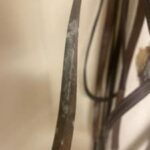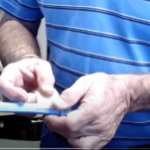English faux gags come in all shapes and sizes, which can be overwhelming and confusing. There are many bits out there that provide similar "gag" effects, but are not true gags, we call them Faux Gags. It is sometimes hard to determine which one is right for your horse, so, today we’re going to break it down.
Below we have compiled a list with pictures of these "faux gags" to help you decode the word of gags versus "faux gags." (if you want to know more about standard Gags, you can see our previous post here)
General Properties of Faux Gags
Like traditional gags, faux gags aid in lifting your horses head up, however, the cheeks produce varied results and speed of reaction. Ideally gags help you stay in position and elevate your horse’s head rather than pull you down and out of position. The bigger the ring the larger amount of “hoist” you get to take their head off the floor. Also, bigger rings are slower to act and thus work better for horses who tend to overreact with gags.
Faux Gags (in order of leverage):
- 12/5 Inside Loop Full Cheeks with short bit keepers
- 12/5 Inside Loop D Rings
- 12/5 Inside Loop Loose Rings
- Bauchers (also known as Bouche Filet, Hanging Cheek
- 2 Rings
- 12/5 Inside/Outside Loop
- 12/6 (Bevel) Inside Loops
- Swivels
- 2.5 Rings
- 3 Rings
- 4 Rings
- Gag Curbs (french gags)
These are referred to as "Hunter Gags," due to the fact the loops are concealed. These are in the grey area of the USEF rules and fall under Judges discretion, this is of no issue with the Jumpers. As with all these types of bits, they are predicated on the amount of gag required.
2 Rings are similar to Baucher Bits with a notable differences. First, because they are on a loose ring rather than a fixed cheek, this allows for more travel of the mouthpiece in an upward "gag" direction. Second, Baucher Bits have a smaller snaffle ring which makes them much more fast acting. A baucher's gag action is directly proportional to the height of the cheek - the longer the distance from the top of the cheek to the mouthpiece the larger the gag effect.
12/5 Inside/Outside Loops
*This are our own custom creation and do not have a picture to show you at this time*
As with all of these types of bits, distance is everything. The outside top ring and an internal loop shorten the distance of lift, thus the outer ring gives more lift than a 12/5 or 12/6 configuration, but less than a 2.5 ring.
12/6 (Bevel) Inside Loops
These are the next step up from 12/5 as they add an additional few inches of rise making it slightly more aggressive in its action.
Swivels produce moderate gag action with full cheek like qualities with face pressure when turning.
2.5 Rings are almost equal to the 3 rings with this exception they tend to be slightly shorter. More importantly, the lower ring is larger, this allows the rein more movement before engaging the ring. This makes them a bit slower to act.
The three and four rings with chains are the mirror opposite of gag curb (french gags) in their actions. A 3/4 ring gags first, curbs second, which means it raises first and breaks at the pole second. If you have a horse that you have to pick up their heads first, but that action causes them to stiffen, locking the withers and back, then 3 rings will not be a good choice for you. We would recommend a gag curb in this case to give you whole body flexibility through the withers and back and compression of step. Gag curbs start at the jaw with a curb and then lift.
Gag curbs start at the jaw with a curb and then lift. Poll pressure is not totally removed as there is a similar action to the ring on the bit & top rein. When deciding between 3 rings and gag curbs they are mirror opposites as mentioned above. Gag curbs Pelham first and then gag.
If you have a horse that you have to pick up their heads first, but that action causes them to stiffen, locking the withers and back, we would recommend a gag curb to give you whole body flexibility through the withers and back and compression of step.
The following bits also have gag type properties when there curb chains or straps are loose or not used:
This is due to the fact that the cheek piece attaches above the mouth piece causing the bit to pivot or move upward when pulled. Elevators always have a gag like property.
About EquuSport Blog
We've spent countless hours hand-picking the best equestrian brands on the market that are designed to solve common tack and training issues. When something doesn't exist to solve a problem, we create it. We regularly customize, modify, and augment bits and tack for customers who are working through very specific issues with their horses.
Have an idea we can explore? Let us know.
Recent Posts
Product Tutorial
Mon. CLOSED | Tue. 1PM-5PM | Wed. thru Sat. 9AM-6PM | Sun. 9AM-4PM *All times are in PST


















